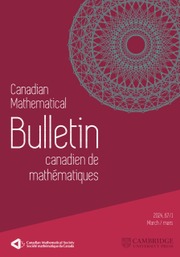No CrossRef data available.
Article contents
Periods of Modular Forms and Imaginary Quadratic Base Change
Published online by Cambridge University Press: 20 November 2018
Abstract
Core share and HTML view are not available for this content. However, as you have access to this content, a full PDF is available via the ‘Save PDF’ action button.
Let  $f$ be a classical newform of weight 2 on the upper half-plane
$f$ be a classical newform of weight 2 on the upper half-plane  ${{H}^{(2)}}$ ,
${{H}^{(2)}}$ ,  $E$ the corresponding strong Weil curve,
$E$ the corresponding strong Weil curve,  $K$ a class number one imaginary quadratic field, and
$K$ a class number one imaginary quadratic field, and  $F$ the base change of
$F$ the base change of  $f$ to
$f$ to  $K$ . Under a mild hypothesis on the pair
$K$ . Under a mild hypothesis on the pair  $(\,f\,,\,K)$ , we prove that the period ratio
$(\,f\,,\,K)$ , we prove that the period ratio  ${{\Omega }_{E}}/(\sqrt{\left| D \right|}{{\Omega }_{F}})$ is in
${{\Omega }_{E}}/(\sqrt{\left| D \right|}{{\Omega }_{F}})$ is in  $\mathbb{Q}$ . Here
$\mathbb{Q}$ . Here  ${{\Omega }_{F}}$ is the unique minimal positive period of
${{\Omega }_{F}}$ is the unique minimal positive period of  $F$ , and
$F$ , and  ${{\Omega }_{E}}$ the area of
${{\Omega }_{E}}$ the area of  $E(\mathbb{C})$ . The claim is a specialization to base change forms of a conjecture proposed and numerically verified by Cremona and Whitley.
$E(\mathbb{C})$ . The claim is a specialization to base change forms of a conjecture proposed and numerically verified by Cremona and Whitley.
Keywords
Information
- Type
- Research Article
- Information
- Copyright
- Copyright © Canadian Mathematical Society 2010
References
[1] Asai, T., On the Doi-Naganuma lifting associated with imaginary quadratic fields. Nagoya Math. J.
71(1978), 149–167.Google Scholar
[2] Cremona, J., Hyperbolic tessellations, modular symbols, and elliptic curves over complex quadratic fields. Compositio Math.
51(1984), no. 3, 275–324.Google Scholar
[3] Cremona, J., Abelian varieties with extra twist, cusp forms, and elliptic curves over imaginary quadratic fields. J. London Math. Soc.
45(1992), no. 3, 404–416. doi:10.1112/jlms/s2-45.3.404Google Scholar
[4] Cremona, J., and Whitley, E., Periods of cusp forms and elliptic curves over imaginary quadratic fields. Math. Comp.
62(1994), no. 205, 407–429. doi:10.2307/2153419Google Scholar
[5] Friedberg, S., On the imaginary quadratic Doi–Naganuma lifting of modular forms of arbitrary level. Nagoya Math. J.
92(1983), 1–20.Google Scholar
[6] Jacquet, H., Automorphic Forms on GL(2). Part II. Lecture Notes in Mathematics 278. Springer-Verlag, Berlin, 1972.Google Scholar
[7] Kurčanov, P., The cohomology of discrete groups and Dirichlet series that are related to Jacquet-Langlands cusp forms. (Russian) Izv. Akad. Nauk SSSR Ser. Mat.
42(1978), no. 3, 588–601.Google Scholar
[8] Mazur, B., and Swinnerton-Dyer, P., Arithmetic of Weil curves. Invent. Math.
25(1974), 1–61. doi:10.1007/BF01389997Google Scholar
[9] Miyake, T., Modular forms. Translated from the Japanese by Yoshitaka Maeda. Springer-Verlag, Berlin, 1989.Google Scholar
[10] Rohrlich, D. E., On L-functions of elliptic curves and cyclotomic towers. Invent. Math.
75(1984), no. 3, 409–423. doi:10.1007/BF01388636Google Scholar
[11] Taylor, R., l-adic representations associated to modular forms over imaginary quadratic fields. II.
Invent. Math.
116(1994), no. 1-3, 619–643. doi:10.1007/BF01231575Google Scholar
[12] Trifković, M., Stark-Heegner points on elliptic curves defined over imaginary quadratic fields. Duke Math. J.
135(2006), no. 3, 415–453. doi:10.1215/S0012-7094-06-13531-7Google Scholar

